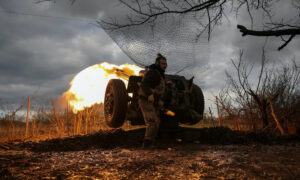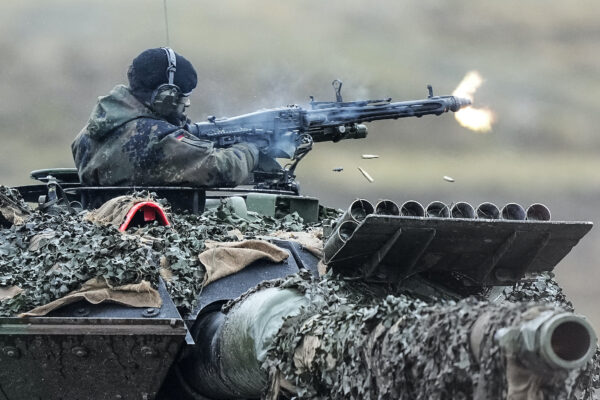War in Ukraine Pushes for Higher Global Military Spending: Swedish Think Tank
Military spending worldwide has increased for an eighth consecutive year in 2022 to reach $2.2 trillion, levels never seen since the end of the Cold War, a Stockholm think tank said on April 24. The military spending values were adjusted for inflation, and an increase of 3.7 percent compared to 2021 was observed, according to a statement from the Stockholm International Peace Research Institute (SIPRI). There was a 13 percent increase in spending in Europe. Military spending is not only arms spending, but also includes other costs, such as salaries and research and development. The United States, China, and Russia were the biggest spenders in 2022. “The continuous rise in global military expenditure in recent years is a sign that we are living in an increasingly insecure world,” said Nan Tian, a senior researcher with SIPRI’s Military Expenditure and Arms Production Program. “States are bolstering military strength in response to a deteriorating security environment, which they do not foresee improving in the near future.” Central and Western European countries spent $345 billion on their militaries, an amount that surpassed that at the end of the Cold War in 1989. It was also a 30 percent increase compared to 2013. A soldier fires a machine gun from a Leopard 2 tank at the Bundeswehr tank battalion 203 at the Field Marshal Rommel Barracks in Augustdorf, Germany, on Feb. 1, 2023. (Martin Meissner/AP Photo) Many countries globally increased their military spending after the Ukraine invasion, and others have set plans to increase their spending in the next decade. “The invasion of Ukraine had an immediate impact on military spending decisions in Central and Western Europe. This included multi-year plans to boost spending from several governments,” said SIPRI’s Diego Lopes da Silva. “As a result, we can reasonably expect military expenditure in Central and Western Europe to keep rising in the years ahead.” Some of the sharpest increases were seen in Finland (+36 percent), Lithuania (+27 percent), Sweden (+12 percent), and Poland (+11 percent). “While the full-scale invasion of Ukraine in February 2022 certainly affected military spending decisions in 2022, concerns about Russian aggression have been building for much longer,” said SIPRI researcher Lorenzo Scarazzato. “Many former Eastern bloc states have more than doubled their military spending since 2014, the year when Russia annexed Crimea.” Russia and Ukraine Raise Military Spending Russian military spending grew by an estimated 9.2 percent in 2022 to around $86.4 billion. This was equivalent to 4.1 percent of Russia’s gross domestic product (GDP) in 2022, up from 3.7 percent of GDP in 2021. Figures released by Russia in late 2022 show that spending on national defense, the largest component of Russian military expenditure, was already 34 percent higher, in nominal terms (not adjusted for inflation), than in budgetary plans drawn up in 2021. “The difference between Russia’s budgetary plans and its actual military spending in 2022 suggests the invasion of Ukraine has cost Russia far more than it anticipated,” said Lucie Béraud-Sudreau, director of SIPRI’s Military Expenditure and Arms Production Program. Ukraine spent $44 billion in 2022, a 640 percent increase, or 34 percent of its GDP, an increase of 3.2 percent compared to 2021. US Raises Spending Despite High Inflation The United States remained the biggest military spender globally, with $877 billion spent in 2022. This accounts for 39 percent of global spending, three times more than China, the second biggest spender, spent on its military. There would be even higher military spending in the United States if not for the highest inflation in the country since 1981. “The increase in the USA’s military spending in 2022 was largely accounted for by the unprecedented level of financial military aid it provided to Ukraine,” said Nan. “Given the scale of US spending, even a minor increase in percentage terms has a significant impact on the level of global military expenditure.” The United States gave $19.9 billion to Ukraine as military aid, 2.3 percent of the total U.S. military spending. “In 2022, the USA allocated $295 billion to military operations and maintenance, $264 billion to procurement and research and development, and $167 billion to military personnel,” according to SIPRI. China and Japan Lead in Asia and Oceania Countries in Asia and Oceania spent a total of $577 billion in 2022 on their militaries. This is a 2.7 percent increase compared to 2021 and a 45 percent increase compared to 2013. The area has seen a continuous upward trend in military spending since at least 1989. China spent $292 billion in 2022, remaining the world’s second-largest spender. This was 4.2 percent more than in 2021 and 63 percent more than in 2013. China’s military expenditure has increased for 28 consecutive years. Japan spent $46 billion, or 1 percent of its GDP, an increase of 5.9 percent

Military spending worldwide has increased for an eighth consecutive year in 2022 to reach $2.2 trillion, levels never seen since the end of the Cold War, a Stockholm think tank said on April 24.
The military spending values were adjusted for inflation, and an increase of 3.7 percent compared to 2021 was observed, according to a statement from the Stockholm International Peace Research Institute (SIPRI). There was a 13 percent increase in spending in Europe.
Military spending is not only arms spending, but also includes other costs, such as salaries and research and development.
The United States, China, and Russia were the biggest spenders in 2022.
“The continuous rise in global military expenditure in recent years is a sign that we are living in an increasingly insecure world,” said Nan Tian, a senior researcher with SIPRI’s Military Expenditure and Arms Production Program.
“States are bolstering military strength in response to a deteriorating security environment, which they do not foresee improving in the near future.”
Central and Western European countries spent $345 billion on their militaries, an amount that surpassed that at the end of the Cold War in 1989. It was also a 30 percent increase compared to 2013.

Many countries globally increased their military spending after the Ukraine invasion, and others have set plans to increase their spending in the next decade.
“The invasion of Ukraine had an immediate impact on military spending decisions in Central and Western Europe. This included multi-year plans to boost spending from several governments,” said SIPRI’s Diego Lopes da Silva. “As a result, we can reasonably expect military expenditure in Central and Western Europe to keep rising in the years ahead.”
Some of the sharpest increases were seen in Finland (+36 percent), Lithuania (+27 percent), Sweden (+12 percent), and Poland (+11 percent).
“While the full-scale invasion of Ukraine in February 2022 certainly affected military spending decisions in 2022, concerns about Russian aggression have been building for much longer,” said SIPRI researcher Lorenzo Scarazzato. “Many former Eastern bloc states have more than doubled their military spending since 2014, the year when Russia annexed Crimea.”
Russia and Ukraine Raise Military Spending
Russian military spending grew by an estimated 9.2 percent in 2022 to around $86.4 billion. This was equivalent to 4.1 percent of Russia’s gross domestic product (GDP) in 2022, up from 3.7 percent of GDP in 2021.
Figures released by Russia in late 2022 show that spending on national defense, the largest component of Russian military expenditure, was already 34 percent higher, in nominal terms (not adjusted for inflation), than in budgetary plans drawn up in 2021.
“The difference between Russia’s budgetary plans and its actual military spending in 2022 suggests the invasion of Ukraine has cost Russia far more than it anticipated,” said Lucie Béraud-Sudreau, director of SIPRI’s Military Expenditure and Arms Production Program.
Ukraine spent $44 billion in 2022, a 640 percent increase, or 34 percent of its GDP, an increase of 3.2 percent compared to 2021.
US Raises Spending Despite High Inflation
The United States remained the biggest military spender globally, with $877 billion spent in 2022. This accounts for 39 percent of global spending, three times more than China, the second biggest spender, spent on its military.
There would be even higher military spending in the United States if not for the highest inflation in the country since 1981.
“The increase in the USA’s military spending in 2022 was largely accounted for by the unprecedented level of financial military aid it provided to Ukraine,” said Nan. “Given the scale of US spending, even a minor increase in percentage terms has a significant impact on the level of global military expenditure.”
The United States gave $19.9 billion to Ukraine as military aid, 2.3 percent of the total U.S. military spending.
“In 2022, the USA allocated $295 billion to military operations and maintenance, $264 billion to procurement and research and development, and $167 billion to military personnel,” according to SIPRI.
China and Japan Lead in Asia and Oceania
Countries in Asia and Oceania spent a total of $577 billion in 2022 on their militaries. This is a 2.7 percent increase compared to 2021 and a 45 percent increase compared to 2013. The area has seen a continuous upward trend in military spending since at least 1989.
China spent $292 billion in 2022, remaining the world’s second-largest spender. This was 4.2 percent more than in 2021 and 63 percent more than in 2013. China’s military expenditure has increased for 28 consecutive years.
Japan spent $46 billion, or 1 percent of its GDP, an increase of 5.9 percent compared to 2021. It was its highest military spending since 1960.
“A new national security strategy published in 2022 sets out ambitious plans to increase Japan’s military capability over the coming decade in response to perceived growing threats from China, North Korea, and Russia,” according to SIPRI’s report.
“Japan is undergoing a profound shift in its military policy,” said Xiao Liang, a researcher with SIPRI. “The post-war restraints Japan imposed on its military spending and military capabilities seem to be loosening.”
Other Countries
India spent $81.4 billion on its military, becoming the fourth spender globally.
Saudi Arabia spent an estimated $75 billion.
NATO members spent a total of $1.2 trillion, and the United Kingdom spent $68.5 billion, the highest military spending in Central and Western Europe, with an estimated $2.5 billion (3.6 percent) as military aid to Ukraine.












